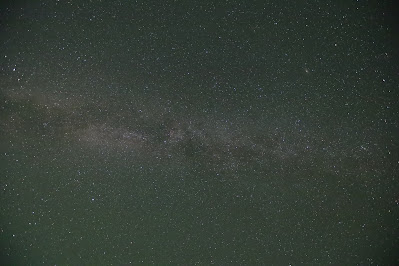These photos from my travel trip to New Mexico Very Large Array.
The Karl G. Jansky Very Large Array (VLA) is a radio astronomy observatory located in central New Mexico, USA.
%20Sign%20at%20Night.jpg) |
| The Karl G. Jansky Very Large Array (VLA) Sign at Night |
The VLA was first proposed in the 1960s as a replacement for the older National Radio Astronomy Observatory (NRAO) antennas. Construction began in 1973, and the VLA was completed in 1980. The VLA consists of 28 dish antennas that can be arranged in different configurations to observe different parts of the sky.
 |
| Radio Telescope at Night |
The VLA is a powerful tool for radio astronomy, as it is capable of observing a wide range of celestial objects, including stars, galaxies, and black holes. Because the VLA observes in the radio frequency range, it can see through dust clouds and other obstructions that would be opaque to visible light telescopes.
 |
| VLA Radio Telescope at Night |
One of the most famous scientific discoveries made using the VLA was the confirmation of the existence of black holes. In 1974, astronomers using the VLA observed a radio source called Cygnus X-1, which was suspected to be a black hole. By observing the orbital motion of a companion star to Cygnus X-1, the astronomers were able to confirm that it was indeed a black hole.
 |
| Sky Reflection - Crystal Ball |
In addition to the discovery of black holes, the VLA has made many other important scientific discoveries. For example, in 1998, astronomers using the VLA discovered the first radio-emitting magnetar, a type of neutron star with an extremely powerful magnetic field. The VLA has also been used to study the properties of interstellar gas and dust, as well as the formation of stars and galaxies.
 |
| VLA Sign |
The Karl G. Jansky Very Large Array (VLA) was also featured prominently in the 1997 science fiction film "Contact", based on the novel by Carl Sagan. The film tells the story of a scientist named Ellie Arroway, played by Jodie Foster, who uses the VLA to search for extraterrestrial intelligence.
 |
| NRAO |
In the film, Arroway and her team use the VLA to search for signals from other civilizations in the universe. The VLA's ability to detect faint radio signals from distant objects is crucial to their search, as they believe that other intelligent beings may use radio waves to communicate with one another.
 |
| Radio Telescope |
"Contact" is a science fiction film that features the Karl G. Jansky Very Large Array as a key element in its plot. Although the film's depiction of the VLA is largely fictional, it did raise awareness of the observatory and its capabilities among the general public. The VLA remains a powerful tool for scientific research, and its ongoing use by astronomers and other scientists continues to expand our understanding of the universe.

















































